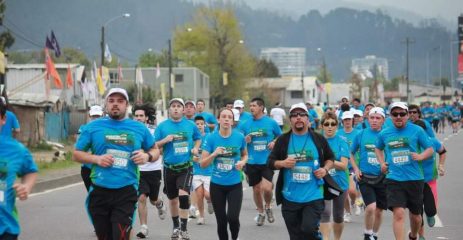By Josefina Rioseco Vallejos
Introduction
- Between 2006 and 2016 the Chilean government increased its investment in sport as part of an overall Sport and Physical Activity (PA) Policy aimed at improving infrastructure, participation and the promotion of sport and PA.
- By 2017 the government had established national minimum activity guidelines for participation as 75 or 150 minutes of moderate or vigorous PA a week for those over 18, and 60 minutes of moderate activity a day for those under 18.
- In one year alone, 2018, the equivalent of £50 million had been invested in the development of seven projects.
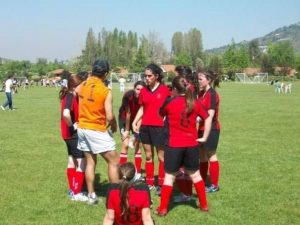 The 2018 national PA activity survey for over 18s, identified that 8 out of 10 Chilean over 18 are physical inactive, while the report card for PA for children and youth identified Chile with the lowest overall average participation rate amongst the 40 countries included.
The 2018 national PA activity survey for over 18s, identified that 8 out of 10 Chilean over 18 are physical inactive, while the report card for PA for children and youth identified Chile with the lowest overall average participation rate amongst the 40 countries included.
Social and Demographic Background
With a population of about 18 million people, Chile is a socially, culturally and demographically rich and diverse country. The different ethnic groups as a % of the population includes: white and non-indigenous 88.9%, Mapuche 9.1%, Aymara 0.7%, other indigenous groups 1% (includes Rapa Nui, Likan Antai, Quechua, Colla, Diaguita, Kawesqar, Yagan or Yamana), unspecified 0.3% (2012 est.) A rich group of languages that reflects its history and cultures including Spanish 99.5% (official), English 10.2%, indigenous 1% (includes Mapudungun, Aymara, Quechua, Rapa Nui), other 2.3%, unspecified 0.2% (2012 est). In terms of religion from largest to smallest groups Chile consists of Roman Catholic 66.7%, Evangelical or Protestant 16.4%, Jehovah’s Witness 1%, other 3.4%, none 11.5%, unspecified 1.1% (2012 est.)
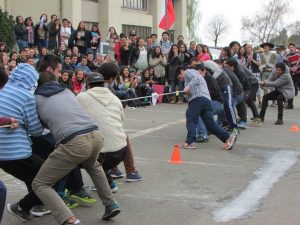 Chile is in the advanced stages of demographic transition and is becoming an ageing society – with fertility below replacement level, low mortality rates, and life expectancy on par with developed countries.
Chile is in the advanced stages of demographic transition and is becoming an ageing society – with fertility below replacement level, low mortality rates, and life expectancy on par with developed countries.
Nevertheless, with its dependency ratio nearing its low point, Chile could benefit from its favourable age structure. It will need to keep its large working-age population productively employed, while preparing to provide for the needs of its growing proportion of elderly people, especially as women – the traditional caregivers – increasingly enter the workforce.
Over the last two decades, Chile has made great strides in reducing its poverty rate, which is now lower than most Latin American countries. However, severe income inequality means it has a low rank among members of the Organization for Economic Cooperation and Development.
Unequal access to quality education perpetuates this uneven income distribution.
Sport and Physical Activity Trends
The National Sport and PA survey (2018) for over 18 years, showed that 66.2% of people in this category were physically inactive. A position that had slightly improved when compared to 2006.
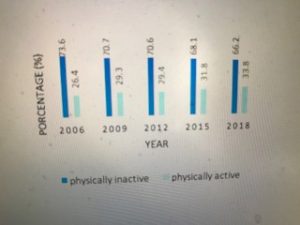 For those aged between 5 and 18 years , the“Report card on PA for children and youth” 2018, graded Chile with the lowest overall average (“D” of a “A” to “D” scale, with A being the highest and “D” the lowest) among 40 evaluated countries.
For those aged between 5 and 18 years , the“Report card on PA for children and youth” 2018, graded Chile with the lowest overall average (“D” of a “A” to “D” scale, with A being the highest and “D” the lowest) among 40 evaluated countries.
A grade that was based upon 20% of the age range meeting PA requirements, and only 14,4% (Girls) and 26,3% (Boys) having participated regularly in organized sport.
Also, 1 out of 5 children from 8 to 18 years were physically active.
For adults aged between 18 and 39 participation rates rise to 43% representing the largest physically active age segment of the population. It then decreased to 32,5% and 21,9% for 40-49 and 50-59 respectively. Only 25% of the elderly are deemed to be active.
Regarding to gender differences, Chilean men adults are generally more active than woman adults (45,3% vs 25,6%). As for youths the trend is similar, been boys more active than girls (45% vs 16%).
Lastly, socioeconomic status (SES) in Chile is directly related to rates of physical inactivity: 82,5% of the lower-incomes population are physically inactive (82,5%). This gradually improve throughout the higher-incomes status (51,9%).
Reasons
The reasons given for such rates of activity and inactivity vary between different sections of the population.
Gender
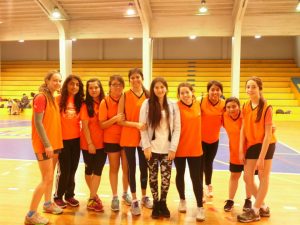 Some of the key cited reasons within the national survey for over 18 years included: “lack of time” due to work is the most popular reasons for refusing PA for both genders.
Some of the key cited reasons within the national survey for over 18 years included: “lack of time” due to work is the most popular reasons for refusing PA for both genders.
Besides working schedules, women are often also responsible of child-caring and house duties, reducing time for other sport activities.
Furthermore, “lack of motivation” is given as a common reason in woman who are more likely to spend their free time watching TV rather than exercise than men.
Lastly, women tend to assume PA as a health constructor rather than contributing as an entertainment element- a factor that the survey cites as a reason for decreased engagement.
Youth
As for youths some of the key cited reasons in The Report Card, included stereotypes about men and women, being self-conscious over appearance, lack of support by peers and schools and the fact that sport and PA opportunities provided did not match the tastes and preferences wanted by Chilean youth.
Elderly
As for elderly some of the key cited reasons within the national survey included illness and disease that rendered some of the elderly inactive. Other reasons include lack of support provided either by their family or communities or both and having limited spaces to be safely active. Lastly, the adverse effect of having low-incomes due to an unsatisfactory pension system meant that some choices open to others were limited including the cost of access to sport venues.
Socio-economic status
Some determinants of lower SES on PA and sport have been recognised with the differences in annual incomes (£2,000 vs £17,000) having consequences for those on lower incomes as it leads, for example, to limited access to PA facilities when compared with the most affluent groups.
Solutions
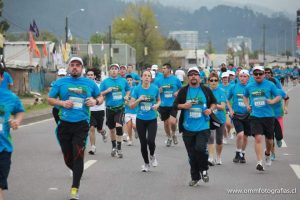 While recognising that contexts are vitally important to fully understanding what is happening in country X or Y and what the solutions might be. A number of suggestions might be considered by the Chilean Government.
While recognising that contexts are vitally important to fully understanding what is happening in country X or Y and what the solutions might be. A number of suggestions might be considered by the Chilean Government.
- Schools and teacher’s commitment are needed to create life-long motivation, habits and wider participation in physical activity and sport for all children and youths.
- Safe and accessible and spaces should be improved, expanded, and accompanied by a range of activities delivered qualified staff to engage elderly in sport participation.
- Social support for programmes are vital for all age ranges, and can be addressed by getting families, friends and peers involved.
- Woman’s participation rates need to be increased in schools, by choosing sports and modes of delivery according to woman’s preferences and needs.
- Educational workshops also need to address negative attitudes by males towards female sport participation. An increase in the number of leadership roles for women in sport in Chile needs to be advanced. Equality in sport necessitates not just equality in terms of participation but also representation on boards and the media.
- Workplaces should consider implementing strategies to enhance sport and physical activity in the workplace, joining local sport leagues, hosting internal sport leagues, taking work team off-site for lunch workouts and hosting wellness workshops.
- It is necessary to address the barriers contributing to low participation amongst low socio-economic groups including facilitating greater access to sport venues, fitness classes, hosting local leagues, delivering sport workshops, increasing opportunities for engagement by firstly recognising and then addressing structural barriers to involvement.
- Committed long term public and private sponsors to support lower SES population would be a significant enabler.
Concluding Remarks.
With population of about 18 million total Chile has an issue with physical inactivity in specific demographic populations, as 8 out of 10 Chileans over 18-year-old are physical inactive. If government funding targeted an increase in the PA and sport budget for specific populations (youths, women, elderly and low-SES), the physical inactivity levels could be reduced.
Increasing levels of PA and sport participation, can not only help with the development of life-long habits, facilitate preventative spend, a healthier overall population, while supporting evidenced outcomes in other areas of social life such as education, labour, and reducing an inequality gap.
Some observations on sports and physical activity in Chile is the most recent of the Sport Matters research blogs that has focused upon aspects of sport in Chile. It adds to the information provided about The Fútbol Más Program covered in the January 2018 edition of Sport Matters.

